A nationally coordinated approach to protecting Australia’s remaining forests and restoring them at scale will create at least 18,600 new jobs, all of which will be in based in regional Australia.
This includes a growing timber industry. Plantations already account for 86% of Australia’s wood production (1), and Labor has committed to expand the plantation base.
Creating expert, local workforces with strong regional identities that deliver on national biodiversity and emission reduction goals requires an industry plan including carefully designed policy settings and workforce planning and training.
Introduction
The Australian Government has an enduring responsibility to protect Australia’s environment and natural resources and a proud history of national environment achievement.
In 2022, Labor can build on this legacy and extend protection to Australia’s remaining native forests and commence the long-term work of regenerating native forests across the nation.
Native forest protection and regeneration will generate a long-term uplift in regional employment and industrial diversification that will restore biodiversity in our forests, store carbon, and manage and suppress devastating fires, while arresting Australia’s devastating rates of logging and clearing.
Protecting and enhancing nature is a key tool in arresting climate change.
Land-use change accounts for 23% of global emissions, whilst forests and land-use related actions have the potential to deliver up to 30% of the emissions reductions needed for 1.5 degrees. (2)
Australia’s forests store 21,949 million tonnes of carbon (3) and are a critical part of addressing climate change. Restoring forest on 13 million hectares over the next 30 years would deliver additional carbon abatement of 13MtCO2e annually by 2030 (4) and regenerate a portion of Australia’s 52 million hectares of severely degraded land (5).
The 2021 State of the Environment Report detailed the dire state of environmental health in Australia and the crashing of species numbers.
Loss of habitat, through logging and clearing is the key driver of the biodiversity crisis. Increasingly the links between the biodiversity and climate crises, both problem and solution, is being recognised.
Australia has the potential to build a globally significant carbon and biodiversity ‘sink’ and with it a sophisticated industry providing jobs across regional Australia.
Emerging carbon and biodiversity markets both domestically and internationally will create significant demand for high integrity and robust credits created by protecting and managing Australia’s remaining native forests and the long-term work of regenerating native forests across the nation.
A comprehensive program to protect remaining native forests and regenerating forest is intrinsic to achieving Labor’s commitment to action on climate change.
This industry will be a major piece in delivering Australia’s commitment to ending deforestation as committed by the Glasgow Leaders’ Declaration on Forests and Land Use (6), delivery of Australia’s 2030 emissions reduction and biodiversity protection targets and implementation of the recommendations of the 2020 Royal Commission into Natural Disaster Arrangements (Bushfire Royal Commission).
The health of our natural environments underpins the productivity of our economy and health of our society. If Australia fails to protect, restore and build its natural assets there will be long-term costs to the economy, Indigenous and regional employment prospects and the well-being of our communities and society.
Achieving the public policy goals of maximising environmental outcomes for Australia’s forests through the lens of carbon, biodiversity and fire management – will require carefully calibrated policy settings to incentivize protection and restoration in highest priority areas.
Coordination between the environment, climate change, employment, education and agriculture ministries will be essential, as will good data to underpin outcomes.
The opportunity before us is to build a strong regional forest management and restoration industry, attract billions of dollars of new investment via the carbon and biodiversity markets, create 18,600 new regional jobs, and protect and build Australia’s natural wealth as part of a whole of government forest protection and regeneration program.
While unemployment numbers are dropping across the country, it is worth noting that the average number of unemployed people in regional Australia over the 12 months to July was 179,000.
This is a disproportionate amount of the average number of total unemployed, currently 474,000.
Over 2021-22 there were 57,000 regionally unemployed in NSW and 62,000 in Queensland, two of the focus states for the protection and regeneration agenda. Furthermore, youth unemployment is still stubbornly high in regional Australia.
These are new jobs and repurposed jobs (from current destructive economic use) in places where jobs are needed.
The New Forest Workforce: creating a skilled regional growth industry
Protecting and restoring Australia’s forests is more than just an environmental initiative – it is about building a new regional forest management and restoration industry employing more than 18,600 additional people across Australia.
A comprehensive plan to protect and manage all of Australia’s existing forests and to regenerate millions of hectares of degraded land will create good quality long term jobs for regional Australians and First Nations communities. (7)
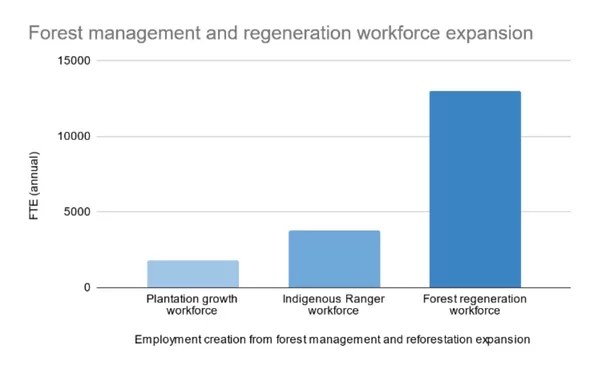
Managing and regenerating Australia’s forests requires a complex workforce of skilled professionals. These include machinery operators, ecologists, botanists and field scientists, Indigenous Rangers, fire managers, land managers, surveyors, drone pilots, tree planters, and native nursery technicians.
As the land management and restoration sector grows, the complexity and size of the task for the industry will require nationally coordinated development of skills, permits, funding and workforce development.
This includes coordinated policy support across multiple portfolios and targeted training to ensure the sector has a professionalised skill set and offer long term and quality employment prospects for regional Australia.
In additional, the forest protection and regeneration industry will deliver long term sustainability and productivity outcomes to the agricultural sector by improving vegetation cover, water retention and soil health.
The workforce to deliver this vision will be a mix of private, public and community – such as Landcare and local cooperatives. Each of these sectors needs its own workforce plan and coordination between them.
Good governance that directs investment to the highest priority areas for national public policy goals will be essential.
The growing carbon and biodiversity credit market provides an unprecedented opportunity for private capital to support the forest protection, management and restoration industry at scale.
The availability of long-term finance and credit revenue will be central to creating secure, good quality jobs for regional and First Nations communities.
A review of current delivery practices now needs to occur to ensure the growing industry delivers secure work and career pathways.
Priority 1: Protect and manage Australia’s remaining native forests
Establishing a vibrant and long-term native forest workforce requires first protecting Australia’s remaining native forests from land clearing and logging. Labor can build on its legacy of pioneering environmental leadership by working across portfolios to protect remaining forests.
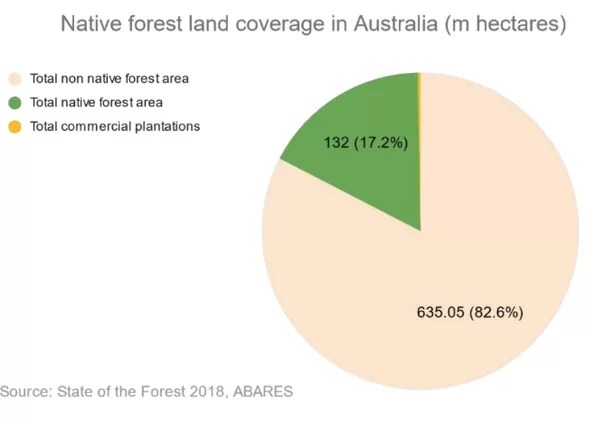
An estimated 44 per cent of Australian forests and woodlands have been cleared since European settlement (8) with less than 1/5th of the continent covered by forest today.
Australia remains a global deforestation hotspot, with Eastern Australia identified as one of the 24 global hotspots, the only developed nation location identified (9).
Australia cleared an additional 7.7 million hectares (10), an area larger than Tasmania, between 2000- 2017, much of it was threatened species habitat.
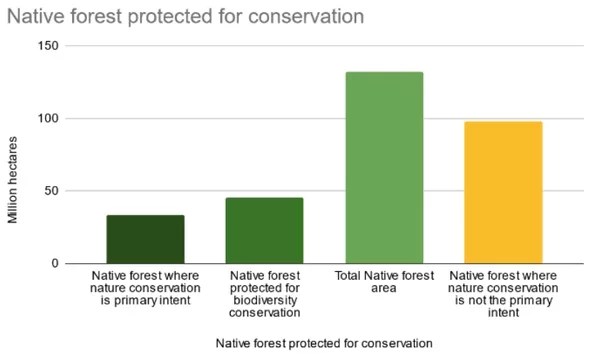
This is not an historical issue. Latest Queensland Government data reveals that 680,000 ha of forests were cleared in 2018-19 in that state alone. (11)
In 2015-16, 73,000 hectares on public land was logged with an average of 78,000 hectares over the years 2010-2016. These figures do not include rates of logging on private land. (12)
Only 46 m hectares of Australia’s remaining 132 m hectares of native forest is protected for biodiversity or nature protection (13).
There are 88.2 m hectares of forest on private freehold land and lease hold land, while only 31.5 m hectares of forest are located in conservation reserves or multiuse public forests.
Protected forests require on-going management for both carbon and biodiversity outcomes, increasingly this includes managing for fires. This requires fewer people than replanting.
The International Union for the Conservation of Nature (IUCN) recommends an ideal ratio of one land manager for every 1,000 ha.
Although 0.3-1 land manager for every 1,000 ha is sufficient in larger areas. (14) Carbon and biodiversity payments will underpin existing and new jobs in land management across the public and private forest estate.
It is difficult to accurately quantify current jobs in native forest logging.
Government figures combine employment figures for the plantation and native forest sectors – 8,984 people in 2016-17 were employed nation-wide in the growing, management and harvesting of timber, including planting, pruning and thinning, growing nursery stocks and logging (15).
In the same period 86% of all logs harvested in Australia were from the plantation sector. (16) If we apply this percentage to the jobs figures, we can assume native forest logging employs around 1,258 nationally.
Many of the jobs in the native forest industry will be re-purposed for the on-going management task of protecting carbon stocks and biodiversity. These are on-ground jobs, that will utilise the deep knowledge of forests of those in the native forest logging industry.

Primary drivers of forest loss
Agricultural land clearing is the primary driver of deforestation in Australia, responsible for 85% (17) of all clearing. Logging of native forests is the other primary driver of forest loss – with 21.3% of remaining native forest currently identified as suitable and available for wood production.
High level coordination between the environment, climate change and agriculture portfolios will be crucial to prevent further deforestation and build a new forestry sector centred on protection, carbon and biodiversity retention, and fire management.
Building a conservation-based forest sector – Existing Policy Commitments
The policy commitments that Labor took to the 2022 Election can be used as the basis to end the clearing of remaining native forests and build a new protection focussed forest workforce.
Environmental Law Reform and the establishment an independent EPA (18)
Labor can use its commitment to revamp environmental laws to strengthen and utilize the EPBC Act to protect threatened species habitat from land clearing by private and state enterprises.
The development and enforcement of strong national standards to protect and restore threatened species habitat, including through application of these standards to RFA region, can be delivered via the establishment of an independent federal Environment Protection Agency.
Recentralising policy and coordination at the federal level through an EPA is critical to ending agriculture clearing and logging of native forests. This can include a review of Regional Forestry Agreements with updated scientific data, climate change impacts and accurate wood supply availability.
Double the number of indigenous rangers and boost funding for Indigenous Protected Areas (19)
Labor’s commitment to fund 3,800 Indigenous Ranger positions (20) by the end of the decade is an opportunity to create a permanent funding, away from time bound grant-based funding, to create stable long term employment opportunities for First Nations communities in forest protection.
Indigenous organisations currently manage 119 million hectares of land – a sixth of the continent – and this commitment will create long term employment in native forest protection.
Independent ACCU Review (21) and Safeguard Mechanism Review (22)
The concurrent reviews of the Safeguard Mechanism and ACCU’s is an opportunity to fix the carbon credits and emerging models of biodiversity credits and turbocharge investment in genuine forest protection and regeneration activities.
These mechanisms can be used to direct the billions of dollars required to protect existing forest on both private and public land.
The creation of a long-term funding stream is the key step in creating secure employment for the growing forest protection and restoration workforce as well as providing compensation and new industry opportunities for former economic users of native forests and current land managers.
A Future Grown in Australia (23) – end native forest logging and shift to 100% plantation
Labor’s commitment to the one billion trees goal to meet Australia’s future timber needs provides an opportunity to end native forest logging completely and shift the domestic forestry sector to a 100% plantation timber supply.
Priority 2: Restore and regenerate Australia’s native forests
Establishing a large land regeneration industry underpinned by long term financial security is critical if Labor is to achieve its commitment to deliver Net Zero Emissions by 2050 and achieve a 43% reduction in emissions by 2030.
The development of a sophisticated long-term forest regeneration industry is an opportunity for Labor to build a vibrant new regional industry that, with careful development, will provide good quality and secure jobs for regional and Indigenous Australians.
There are 52 million hectares of severely degraded land in Australia that costs the nation $224 billion annually in lost ecosystem services and production capacity (24).
Research by the Wentworth Group of Concerned Scientists has calculated that restoring vegetation cover on 13 million hectares over 30 years would deliver carbon abatement of 13MtCO2e annually by 2030 and 26MtCO2e annually by 2050 (25).
Regenerating this amount of land would create a 13,000 strong forest regeneration workforce (26) with additional employment generated in supporting services including expansion of the native nursery sector, technical services from drone pilots, scientists and machinery operators.
Restoring this land would require an investment of $41.5 billion (NPV) over 30 years and generate carbon revenue of $46 billion (NPV) with carbon credits priced at $15 per tonne (27) and increasing 10% per year (the current ACCU trading price is $28 (28).
Expanding plantation forestry
The plantation sector needs to expand by 400,000 hectares over the next 10 years to meet Australia’s timber requirements (29).
The development of new plantations however has collapsed over the past decade.
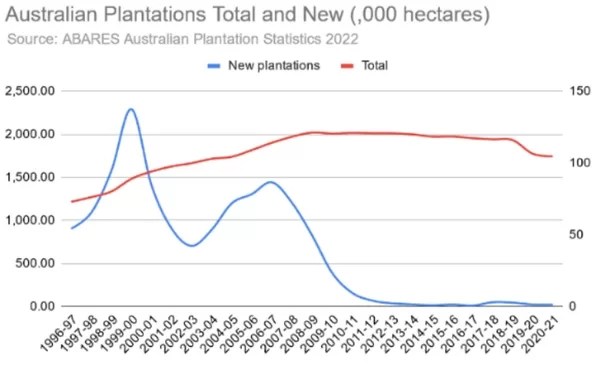
Labor’s A Better Future for our Regions policy will invest $86.2 million (30) in new plantations to get plantation development back on track and help end logging in native forests.
Growing the nursery industry
Increased demand from the regeneration and plantation industry will require Australia’s nursery sector to prepare for a tripling in annual tree seedling production.
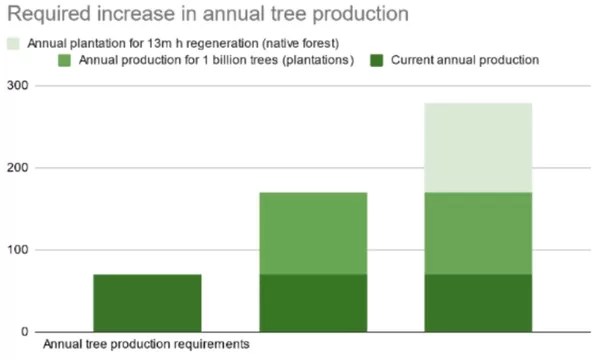
Labor’s A Future Grown in Australia (31) commitment within the National Reconstruction Fund provides a pathway to support industry skill development and innovation in nursery production methods that will help the sector rapidly scale production and meet demand.
Independent ACCU Review (32) and Safeguard Mechanism Review (33)
The independent ACCU review is a critical opportunity to return integrity to the scheme and ensure that credits generated for native forest regeneration projects are genuine and reward high value projects.
The Safeguard Mechanism review is an opportunity to increase demand for Australian ACCUs and help expand the domestic forest regeneration industry.
Building a forest regeneration industry
The policy commitments that Labor took to the 2022 Election and current programs under review can be used as the basis to establish a long term and financially viable forest regeneration sector.
Establishing a strong forest regeneration industry is an opportunity to create a long-term regional workforce that provides job security, opportunities for skill development and specialisation and pride in restoring Australia’s forests and helping the nation build a zero emissions future.
References
(1) State of the Forest 2018, ABARES, p 15
(2) UK Government, materials supporting the Glasgow Leaders Declaration on Land Use and Forests
(3) Australia’s State of Forests Report 2018, Indicator 5.1a
(4) Policy brief for the restoration of degraded ecosystems, Wentworth Group of Concerned Scientists
(5) State of Environment 2021,
(6) The declaration commits Australia to “halt and reverse forest loss and land degradation by 2030”, https://ukcop26.org/glasgow-leadersdeclaration-on-forests-and-land-use/
(7) The Growing a Better Australia plan est. 18k plantation jobs created over 10 years, or 1,800 on average annually.
https://www.agriculture.gov.au/agriculture-land/forestry/publications/growing-better-australia
(8) State of the Environment Report, 2016, https://soe.environment.gov.au/theme/land/topic/2016/regional-and-landscape-scale-pressures-landclearing
(9) Deforestation Fronts, WWF, https://www.wwf.org.au/news/news/2021/australia-remains-the-only-developed-nation-on-the-list-of-globaldeforestation-fronts#gs.8zjlm7
(10) State of the Environment 2021
(11) SLATS Report 2018-19, https://www.qld.gov.au/environment/land/management/mapping/statewide-monitoring/slats/slats-reports/2018-19-report
(12) State of the Forests 2018, ABARES, p 14 Exec Summary
(13) State of the Forests 2018, ABARES
(14) How many Park Rangers are required http://parquesnacionalesdelparaguay.blogspot.com/2022/01/how-many-park-rangers-are-required-for.html
(15) State of the Forest 2018, ABARES p 433 Australia wide grow and log timber in native and plantation forests in 2016 6,027. Those who plant, prune
and thinning trees, reafforestation plantation maintenance and forestry planting stock nurseries is 2, 957. Total 8.984
(16) State of the Forests 2018, ABARES, p 15
(17) triple j, Australia Deforestation https://www.abc.net.au/triplej/programs/hack/australia-deforestation-land-clearing-conservation/13054460
(18) ALP policy – a national environment protection agency https://www.alp.org.au/policies/environmental-law-reform-and-a-national-environmental-protection-agency
(19) ALP policy – Doubling indigenous rangers https://www.alp.org.au/policies/doubling-indigenous-rangers
(20) ALP policy – Doubling indigenous rangers https://www.alp.org.au/policies/doubling-indigenous-rangers
(21) Chris Bowen media release https://minister.dcceew.gov.au/bowen/media-releases/independent-review-accus
(22) Safeguard crediting mechanism https://consult.industry.gov.au/safeguard-crediting-mechanism
(23) ALP policy – A Future Grown in Australia https://www.alp.org.au/policies/a-future-grown-in-australia
(24) State of the Environment 2021, https://soe.dcceew.gov.au/land/management/management-approaches
(25) Policy brief for the restoration of degraded ecosystems, Wentworth Group of Concerned Scientists
(26) Calculated using current industry estimates of 0.03 FTE/Ha for forest regeneration
(27) Policy brief for the restoration of degraded ecosystems, Wentworth Group of Concerned Scientists
(28) Market prices https://www.renewableenergyhub.com.au/market-prices/ 19 August 2022
(29) Dept Agriculture – Growing Better Australia https://www.agriculture.gov.au/agriculture-land/forestry/publications/growing-better-australia
(30) ALP policy – Better Future For Our Regions https://www.alp.org.au/policies/better-future-for-our-regions
(31) ALP policy – A Future Grown in Australia https://www.alp.org.au/policies/a-future-grown-in-australia
(32) Minister media release https://minister.dcceew.gov.au/bowen/media-releases/independent-review-accus
(33) Safeguard Crediting Mechanism https://consult.industry.gov.au/safeguard-crediting-mechanism
For a PDF copy of this page, click here
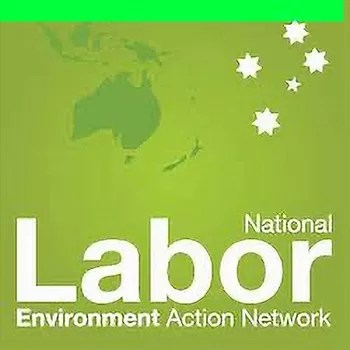
Related stories
The Great Koala National Park without any Koalas
Greater Glider heading for extinction



